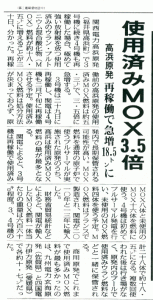Original Japanese written by staffer
The English below translated from the original Japanese by Heeday
The English translation edited by Rev. Dr. Henry French, ELCA
(Based on an article from the January 31st, 2016 edition of the Fukushima Minpo newspaper)
▼Click the image and read the caption.

On January 29th, 2016, Kansai Electric Power restarted the operation of Unit 3 of its Takahama Nuclear Power Plant (NPP), located in Takahama Town, Fukui, some 40 miles north of Kyoto. This was the third NPP unit to be restarted following the enforcement of the new NPP safety regulations, and the first one to be restarted using MOX fuel. (*)
* Known as “Plu(tonium in a) thermal (reactor)” in Japanese, “MOX fuel” is a mixture of uranium and plutonium, an element with deadly high radioactivity. Often, such fuel is used in a reactor designed for uranium fuel, and Takahama is an example of such a reactor. Though MOX fuel results in higher power generation than does uranium fuel, it carries a greater risk of an accident, since it creates more instability. And it produces higher concentrations of radioactive substances. Furthermore, in case a reactor needs to be stopped, the control rods and boric acid—a chemical substance that absorbs neutrons—are less effective on MOX fuel.
Now, Kansai Electric plans to restart Unit 4 of the same NPP late this February.
If things go as planned, it has been estimated that the NPP could produce some 18.5 t (40785 lb.) of used MOX fuel, an increase of almost 3.5 times more than before the restart, approximately 5.3 t (11,700 lb.)
Since MOX fuel emits more radiation than uranium fuel does, it can expose the workers engaged in fuel processing and transportation to more radiation. Therefore, prior to using MOX fuel in a reactor, vary tight control of such fuel is required. In short, MOX fuel is by far more dangerous than uranium fuel. And it remains so after use. Even uranium fuel, after use in a reactor, emits fearful doses of radiation. Used MOX fuel emits even more. This is very dangerous.
Furthermore, the NPP industry has yet to figure out what to do with used MOX. Most likely they will have to store such fuel inside NPPs for a long time. Of those thermal reactors using MOX in Japan, Takahama is expected to produce the greatest volume of used MOX.
Let’s think. Why has Japan been promoting the use of “MOX in thermal reactors”? On this issue, Mr. Hiroaki Koide, formerly an associate professor at Kyoto University Research Reactor Institute (located in Kumatori Town, Osaka) comments as follows. (He has been blowing the whistle against nuclear power over the last four decades.) “Japan built an experimental fast breeder reactor named ‘Monju,’ which is now totally out of work. Meanwhile the nation has been extracting plutonium (out of NPP reactors) to use in the fast breeder reactor. The natural result is that Japan currently has an inventory of some 47 t (103,617 lb.) of extracted plutonium, for which there is no use. Plutonium can fuel atomic bombs as well, and 47 t of it can provide for some 4,000 Nagasaki type bombs. Any country having this much plutonium with no use for it is seen as a threat by most other countries. Now, Japan has made a pledge with the rest of the world that it will never have plutonium without any use for it. Thus, the nation has no other choice but to use plutonium in thermal reactors (common uranium-fueled reactors), although it is evident that this involves serious danger and makes no economic sense.
As described so far, “MOX in a thermal reactor” creates more danger than does a common “uranium-thermal” reactor. Still, Electric Power Development Co., Ltd. (commonly known as “J-POWER”) is now building the Oma NPP, which features the world’s first fully MOX-powered reactor, in Oma, Aomori on the northern end of Honshu Island.
Hazards from Fukushima Daiichi’s meltdown are still plaguing many, and we have yet to see an end to the disaster. The Takahama NPP, which will store a great volume of used MOX fuel, can do even more harm if there is a major accident. If we have more NPP restarts, as the Japanese government proposes, everyone in the archipelago will be exposed to the risk of an NPP disaster. I certainly hope every person will recognize once again how dangerous NPPs are.
